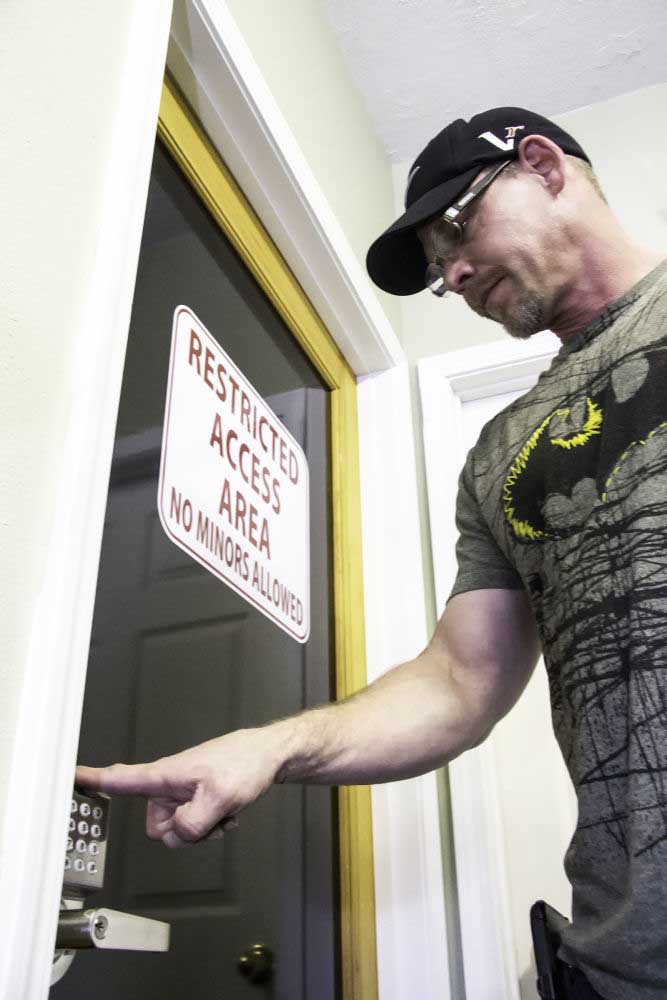From plant to patient
Published 5:00 pm Thursday, March 13, 2014

- <p>Staff photo by Kathy Aney Jim Ruhe, owner and operator of the Releaf Center, uses his fingerprint keypad lock to gain entry into his display area.</p>
For the uninitiated, a medical marijuana card or dispensary license may seem like nothing more than a “get out of jail free” card that puts the holder above the law. But a local dispensary owner says nothing could be farther from the truth.
Jim Ruhe has been operating the Releaf Center, on Highway 395 north of Hermiston, since October 2013. Despite operating outside federal drug laws, he said in Oregon dispensary owners and growers have to contend with a litany of state regulations.
“It’s more than just having control over us,” he said. “They have complete access.”
According to Ruhe, it starts when a patient with a “qualifying condition” sees a doctor. If the physician believes cannabis will help the patient, he or she will fill out a prescription, which the patient then turns in to the state.
If the state approves the patient’s application (it rejected 1,654 in 2013) it will issue an Oregon Medical Marijuana Program card. According to the state, as of January 2014 there were 60,516 card holders in Oregon.
When they receive an OMMP card, patients have three choices: Grow the marijuana themselves, hire someone to grow it for them or (legally since March 3) buy products from a dispensary.
Growing
Information about a patient’s grower and grow site is a required part of the OMMP application. Growers can be legally approved to serve up to four patients and grow up to six plants at a time per patient.
Ruhe said some growers choose to grow outdoors, where their marijuana plants can reach up to 12 feet tall and light is provided by the sun instead of a high electricity bill. But others choose to set up a growing system indoors, where plants will only reach four or five feet tall but are less likely to get stolen or damaged by harsh weather.
“Indoor growing produces better stuff because you can control the atmosphere,” Ruhe said.
A plant usually takes three to four months to grow to maturity. The shade leaves that provide the distinctive seven-point fan are discarded; it’s the buds that are smoked or ingested. Smaller “trim leaves” around the bud are less potent but can be used medicinally, and the stems can be used for salves and tinctures.
Ruhe said some patients will use everything their grower provides but others are a far cry from needing six plants worth of cannabis. People who use a grower instead of a dispensary tend to use more, he said, because they’re not switching up the strains they use and so their body builds up a tolerance.
Supplying
Growers who produce more pot than their patients use are legally allowed to sell the excess to a dispensary like the Releaf Center instead of discarding it. Ruhe said all of his products come from local growers. He either sells it raw or uses lab equipment to create oil-filled capsules, salves, edibles and other products.
When the marijuana comes in it doesn’t go straight to the shelf. Ruhe said by law the new product is “quarantined” in a safe until he is able to test it for THC levels, cannabinoid levels and an absence of mold, mildew and pesticides.
“With a dispensary you know exactly what you’re getting, you know it’s safe, you know how much THC is there,” Ruhe said. “It solves everything.”
He said growers are only allowed to seek reimbursement for growing costs — it’s against the law for them to profit from selling to dispensaries. They also have to come in with paperwork detailing a patient’s permission to sell a specific amount of excess marijuana to a specific dispensary on a specific date.
Selling
Now that the state is officially recognizing dispensaries, Ruhe said it is also insisting on complete accountability.
Auditors from the state will come in at least once a year and comb over the books, levying fines on any dispensary owner who can’t account for every ounce that comes in and out.
“Every piece of product, they know who brought it in the door and who left with it,” Ruhe said.
The law requires high definition color security cameras with battery backup covering the entire store and its entry points. When regulators pop in for a surprise visit Ruhe has to be able to pull up past footage at a moment’s notice and show video of any transaction, proving that no sales took place off the books and that he asked for a OMMP card and driver’s license every time.
Regulators can also check that he followed proper security protocols, locking all marijuana in a safe every night before leaving and using security systems that include a biometric thumb-print scanner and “all the bells and whistles.”
Complying with the new regulations is expensive, Ruhe said, but he does it for the patients. He is a firm believer in cannabis’ healing properties not only for opiate-free pain relief but also for curing cancer.
“I know that’s a bold thing to say,” he said, but he insisted that he has personally seen cases in which megadoses of cannabis oil for three months have vanished malignant tumors.
A handful of studies published in medical journals have suggested that THC may slow tumor growth in animals, but the medical community has yet to present evidence that marijuana use “cures” cancer.
Ruhe, who spent three years in nursing school before putting his education on hiatus to start the dispensary, sees himself as more pharmacist than retailer. Using lab equipment to analyze the strains of marijuana that come in, he helps patients get on a very specific dosage of cannabinoids and THC to stabilize their symptoms.
He starts them on 1/20th of a gram per day (a grape weighs about a gram) and increases the amount over time until they’re at optimum pain relief. Ruhe said someone trying to cure their cancer with cannabis might take three grams. Most of his patients take the marijuana orally in capsules or baked goods.
With 16 of his 500 customers he is conducting clinical trials, keeping detailed notes about dosages and symptoms. He knows he will probably never be published in a medical journal but said he’s performing “repeatable experiments” that he hopes will catch the eye of someone with more resources and credibility.
Contact Jade McDowell at jmcdowell@eastoregonian.com or 541-564-4536.
This story originally appeared in East Oregonian.






